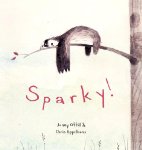Children are not always very accepting when one of their classmates or schoolmates is different. When Henny the chick comes into the world she is missing something very important. Henny has no wings. At all. Instead, she has arms and hands, which makes her rather unique.
 Henny
Henny
 Henny
Henny
Elizabeth Rose Stanton
Picture Book
For ages 5 to 7
Simon and Schuster, 2014, 978-1-4424-8436-8
In almost every respect, Henny is a “typical chicken” She
has a comb on her head, toes with claws, a feather covered body, and a beak.
There is one thing though that Henny does not have. Henny has no wings. Instead,
she has arms. With hands and fingers.
Sometimes Henny
likes her arms because they allow her to do things that the other chicks cannot
do, like climb trees. At other times she does not like the fact that she is
different because the other farm animals laugh at her rather strange
appearance.
Being different
is hard enough when you are a chick, but when you become a grown up chicken,
life becomes even more complicated. Henny’s arms cause her to have a lot of things
to worry about. Is she right or left handed? Should she wear gloves or mittens?
What kinds of clothes should she wear?
While all these
worries are rattling around inside her head, Henny does her best to behave like
a chicken so that she will fit in. She tries to hide her arms, pecking the
ground with her beak instead of using her hands to collect her food. Then
something happens and Henny makes a startling discovery.
Being different
from everyone else can make one’s life different and present challenges that
sometimes seem insurmountable. Often one is trying so hard to fit in that one
does not even consider that being different might actually be a good thing. In
this delightfully sweet, gently funny, and powerful picture book, we might a
character that we quickly grow fond of. Henny is easy to identify with, and her
story, which is accompanied by expressive minimal illustrations, is timeless
and meaningful.








